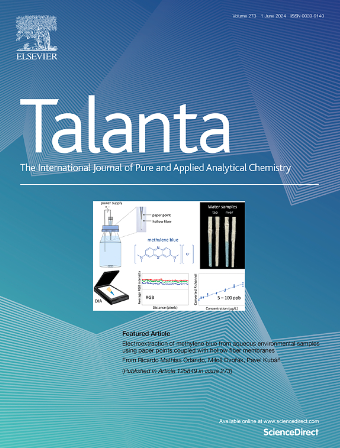Magnetic solid-phase extraction and HPLC-UV determination of fat-soluble vitamins based on a multifunctional monomer covalent organic frameworks
IF 5.6
1区 化学
Q1 CHEMISTRY, ANALYTICAL
引用次数: 0
Abstract
The effective separation of fat-soluble vitamins from complex matrices prior to instrumental analysis remains a significant challenge. Herein, a novel magnetic covalent organic framework (Fe3O4@tetrakis(4-aminophenyl)methane (TAM)-2,6-dihydroxynaphthalene-1,5-dicarbaldehyde (DHNDA), Fe3O4@TAM-DHNDA) was successfully designed and prepared for the efficient separation and enrichment of three fat-soluble vitamins in dairy products. The maximal adsorption efficiency of Fe3O4@TAM-DHNDA to fat-soluble vitamin was as high as 26.94 mg/g. Moreover, the adsorption mechanism of Fe3O4@TAM-DHNDA for VA, VD, and VE was revealed by molecular simulation techniques. van der Waals forces and hydrogen bonds were the main interactions between Fe3O4@TAM-DHNDA and fat-soluble vitamins. Importantly, the magnetic solid phase extraction (MSPE) method based on Fe3O4@TAM-DHNDA could be used as an effective sample pretreatment technology for separation and enrichment of fat-soluble vitamins from complex matrices prior to instrumental analysis. When coupled with high-performance liquid chromatography-ultraviolet detector (HPLC-UV), the proposed method enabled the efficient detection of fat-soluble vitamins in dairy products. The limit of detection (S/N = 3) and limit of quantification (S/N = 10) were achieved at 20–50 ng/mL and 55–150 ng/mL, respectively. Good linearity (R2 > 0.9998) was obtained within the range of 2–100 μg/mL. The average recoveries of spiked milk samples were determined to be 83 %–101 % and the relative standard deviation (RSD) was 0.83 %–3.46 % (n = 3). This work provided novel insights for the development of novel magnetic adsorbents and the separation and enrichment of fat-soluble vitamins in complex matrices.

磁性固相萃取及高效液相色谱-紫外分光光度法测定多功能单体共价有机骨架的脂溶性维生素
在仪器分析之前,从复杂基质中有效分离脂溶性维生素仍然是一个重大挑战。本文成功设计并制备了一种新型磁性共价有机骨架(Fe3O4@tetrakis(4-氨基苯基)甲烷(TAM)-2,6-二羟基萘-1,5-二乙醛(DHNDA), Fe3O4@TAM-DHNDA),用于乳制品中三种脂溶性维生素的高效分离和富集。Fe3O4@TAM-DHNDA对脂溶性维生素的最大吸附效率高达26.94 mg/g。此外,通过分子模拟技术揭示了Fe3O4@TAM-DHNDA对VA、VD和VE的吸附机理。范德华力和氢键是Fe3O4@TAM-DHNDA与脂溶性维生素之间的主要相互作用。重要的是,基于Fe3O4@TAM-DHNDA的磁固相萃取(MSPE)方法可以作为一种有效的样品前处理技术,用于在仪器分析之前从复杂基质中分离和富集脂溶性维生素。该方法与高效液相色谱-紫外检测器(HPLC-UV)相结合,可实现乳制品中脂溶性维生素的高效检测。检测限为20 ~ 50 ng/mL,定量限为55 ~ 150 ng/mL,检测限为S/N = 3。良好的线性度(R2 >;在2 ~ 100 μg/mL范围内得到0.9998)。加样回收率为83% ~ 101%,相对标准偏差(RSD)为0.83% ~ 3.46% (n = 3)。这项工作为新型磁性吸附剂的开发和复杂基质中脂溶性维生素的分离和富集提供了新的见解。
本文章由计算机程序翻译,如有差异,请以英文原文为准。
求助全文
约1分钟内获得全文
求助全文
来源期刊

Talanta
化学-分析化学
CiteScore
12.30
自引率
4.90%
发文量
861
审稿时长
29 days
期刊介绍:
Talanta provides a forum for the publication of original research papers, short communications, and critical reviews in all branches of pure and applied analytical chemistry. Papers are evaluated based on established guidelines, including the fundamental nature of the study, scientific novelty, substantial improvement or advantage over existing technology or methods, and demonstrated analytical applicability. Original research papers on fundamental studies, and on novel sensor and instrumentation developments, are encouraged. Novel or improved applications in areas such as clinical and biological chemistry, environmental analysis, geochemistry, materials science and engineering, and analytical platforms for omics development are welcome.
Analytical performance of methods should be determined, including interference and matrix effects, and methods should be validated by comparison with a standard method, or analysis of a certified reference material. Simple spiking recoveries may not be sufficient. The developed method should especially comprise information on selectivity, sensitivity, detection limits, accuracy, and reliability. However, applying official validation or robustness studies to a routine method or technique does not necessarily constitute novelty. Proper statistical treatment of the data should be provided. Relevant literature should be cited, including related publications by the authors, and authors should discuss how their proposed methodology compares with previously reported methods.
 求助内容:
求助内容: 应助结果提醒方式:
应助结果提醒方式:


